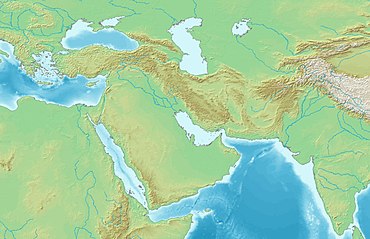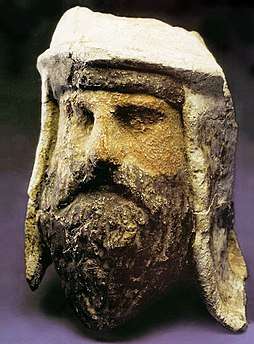Takht-i Sangin
The ancient town of Takht-i Sangin is located near the confluence of the Vakhsh and Panj rivers, the source of the Amu Darya, in southern Tajikistan.
Takht-i Sangin
Painted clay and alabaster head, Takht-i Sangin, Tajikistan, 3rd-2nd century BC. Possibly a Zoroastrian priest.[1]

Takht-i Sangin
Location of Takht-i Sangin in Central Asia.

Takht-i Sangin
Takht-i Sangin (Tajikistan)
Site description
The Greco-Bactrian temple site of Takht-i Sangin is believed by many to be the source of the Oxus Treasure[2] that now resides in the Victoria and Albert Museum and British Museum. Part of greater Transoxiana and built in the 3rd Century BC, the site consists of a well-fortified citadel containing the so-called "Temple of Oxus".[3]
World Heritage Status
This site was added to the UNESCO World Heritage Tentative List on November 9, 1999 in the Cultural category.[3]
Notes
- "Colorado State University".
- Holt, F.L. (1989) p 43
- The Site of Ancient Town of Takhti-Sangin - UNESCO World Heritage Centre
gollark: You are destroying everything over digital signage.
gollark: @Terrariola#0000 this is a stupidity.
gollark: WHY
gollark: Terrariola, I'd like to remind you that tearing up the base over signs is ridiculous.
gollark: Quickly,stop the mad Ferrari ola.
References
- The Site of Ancient Town of Takhti-Sangin - UNESCO World Heritage Centre Retrieved 2009-03-04.
- Holt, F.L. (1989), Alexander the Great and Bactria: The Formation of a Greek Frontier in Central Asia: 2nd Edition, Brill Archive. ISBN 90-04-08612-9
This article is issued from Wikipedia. The text is licensed under Creative Commons - Attribution - Sharealike. Additional terms may apply for the media files.
